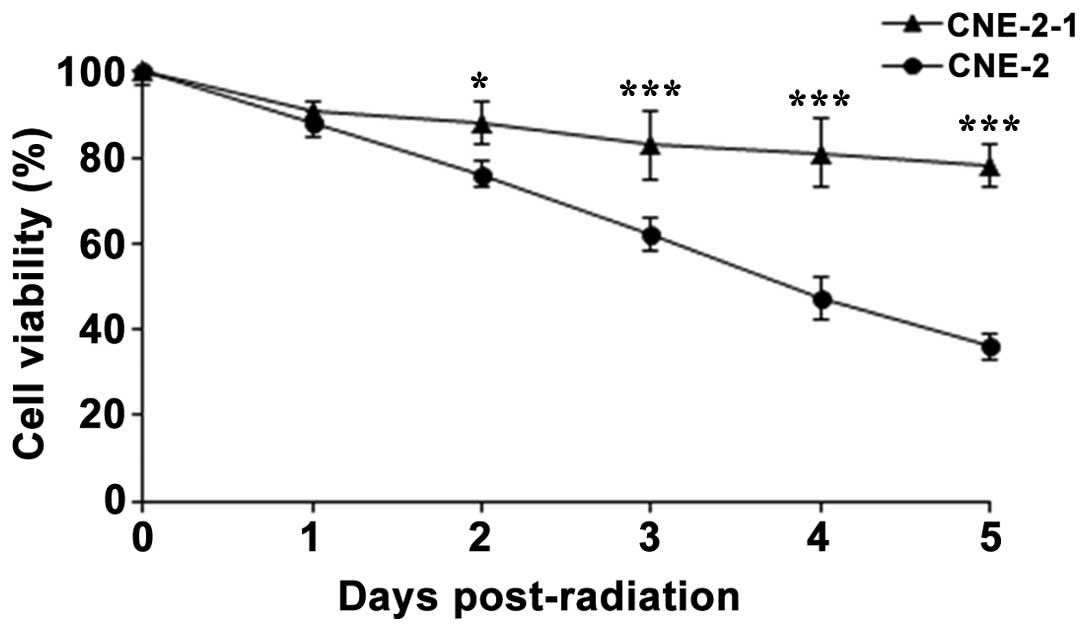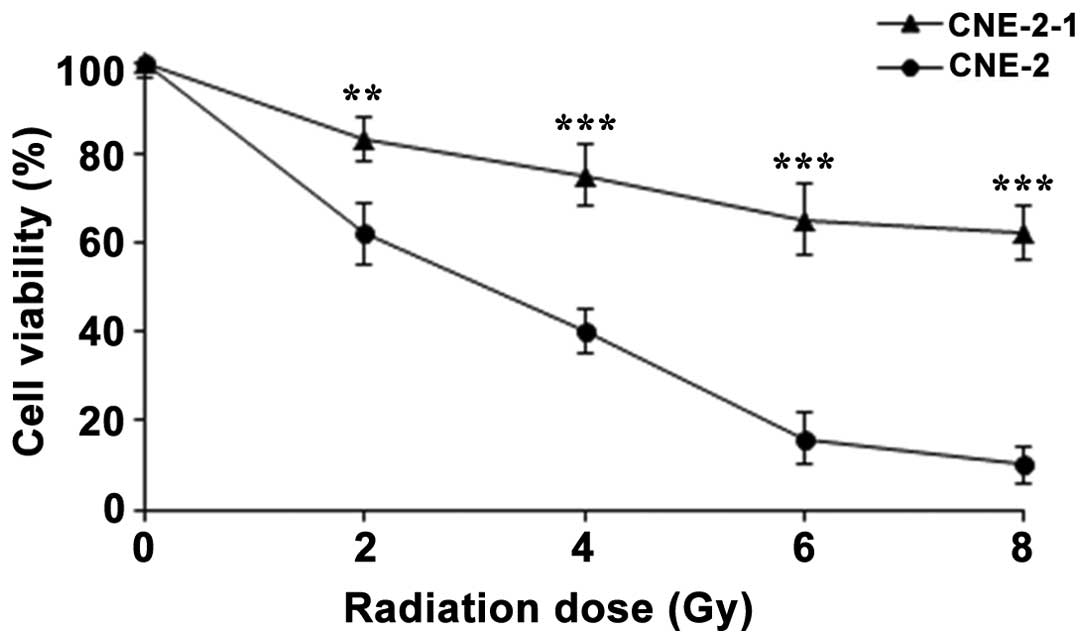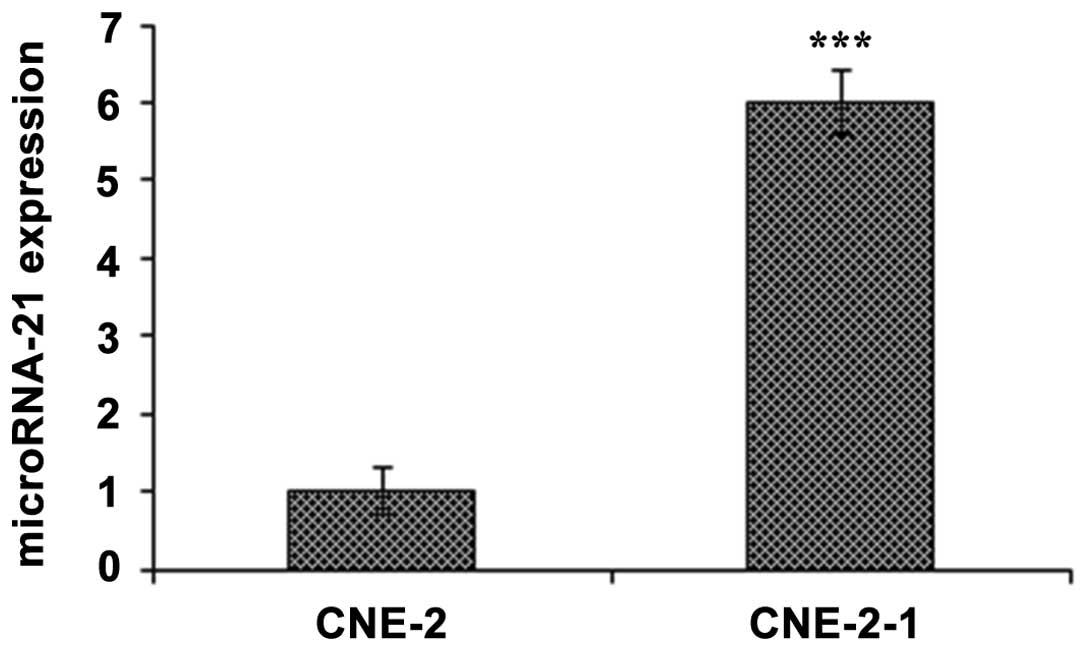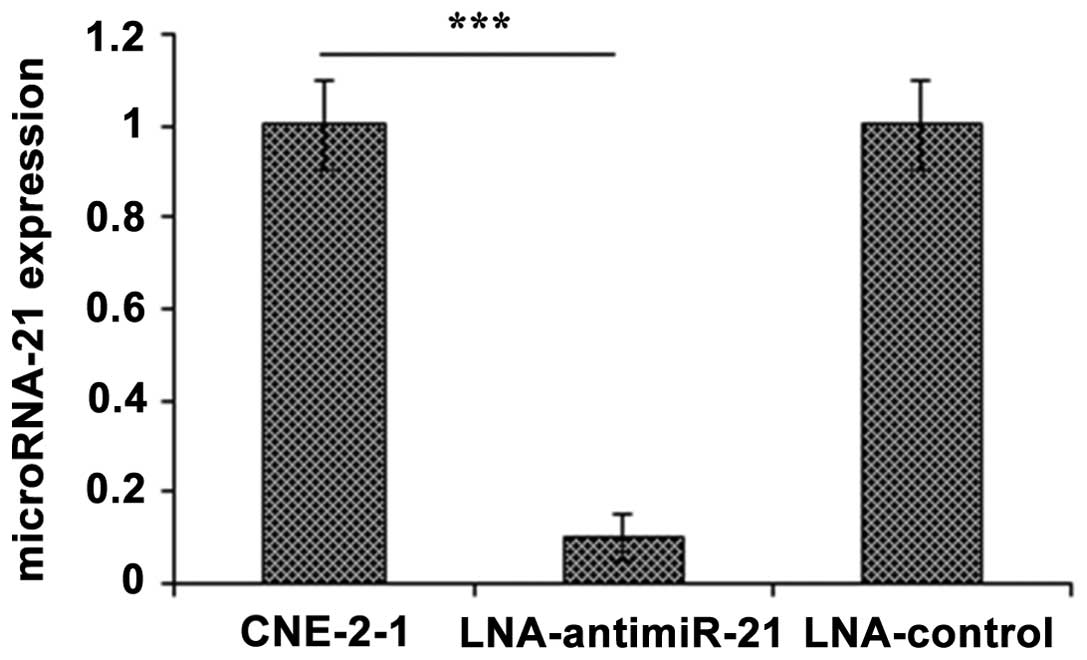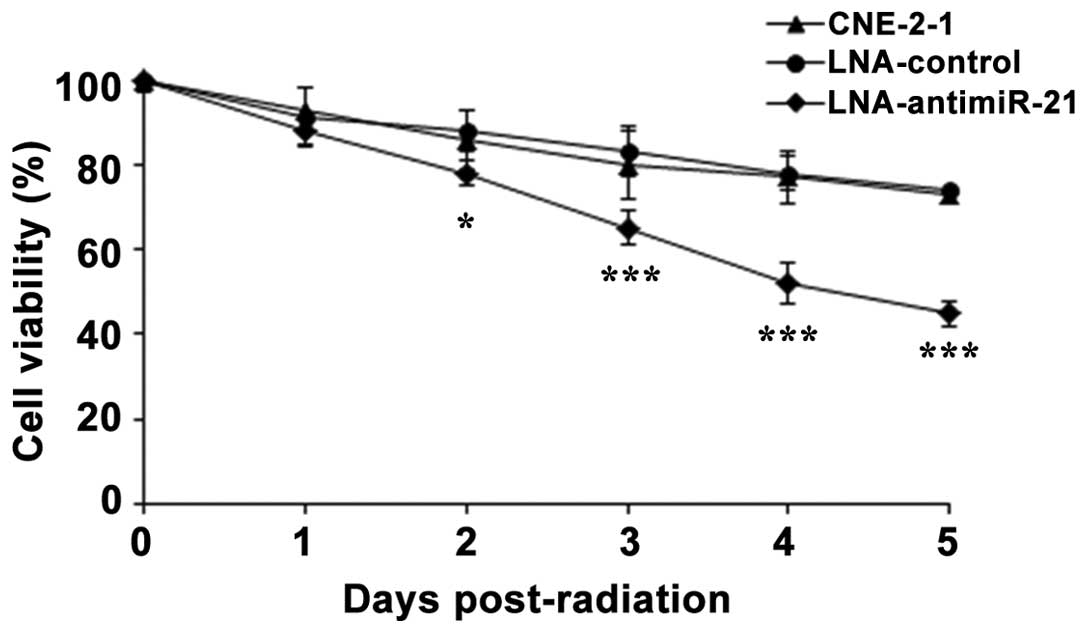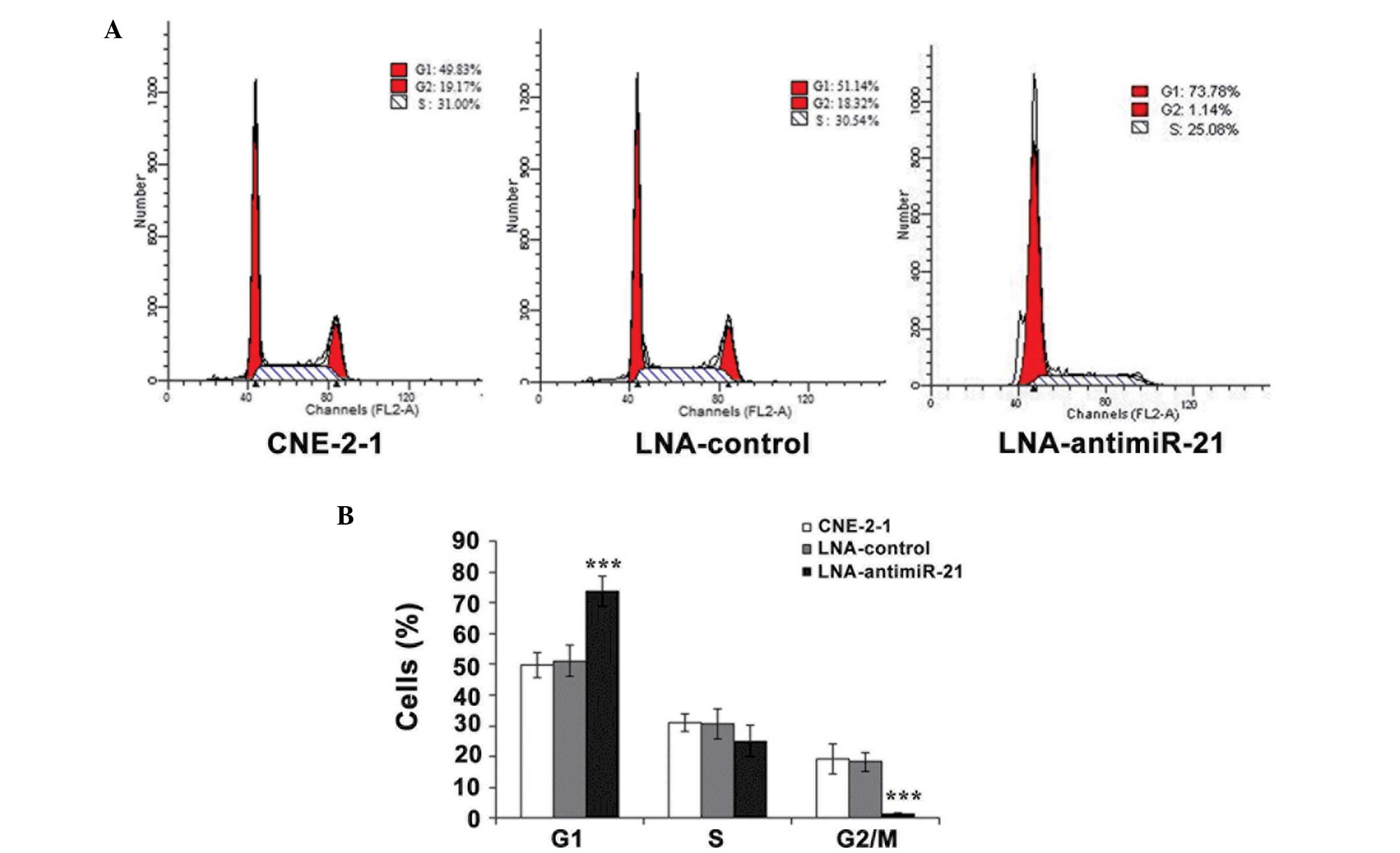Downregulation of microRNA-21 enhances radiosensitivity in nasopharyngeal carcinoma
- Authors:
- Published online on: April 2, 2015 https://doi.org/10.3892/etm.2015.2403
- Pages: 2185-2189
Abstract
Introduction
microRNAs (miRs) are a class of small (19–24 nucleotides), non-coding RNAs that are involved in post-transcriptional gene regulation and/or degradation (1,2). miRs serve a crucial function in the proliferation, differentiation and metabolism of a wide range of plant and animal cell types (3,4). In order to prevent translation or contribute to target mRNA degradation, miRs bind to target mRNAs at the 3′-untranslated region (UTR) and/or the 5′-UTR (5).
Nasopharyngeal carcinoma (NPC) is a non-lymphomatous, squamous cell malignancy arising from the epithelial lining of the nasopharynx, and is particularly common in Southeast Asia (6). NPC is an Epstein-Barr virus-associated cancer (7). The incidence rate of NPC is 30–80/100,000 individuals per year, a rate that has remained consistently high for decades (8). The early symptoms of NPC are not often evident and the majority of patients with NPC are not diagnosed until the advanced stages of the disease. Radiotherapy and chemotherapy are the most common treatment options for NPC, and although the radiotherapy technology has improved considerably over the previous decade, the NPC survival rate remains low (9). A key reason for this is the resistance of NPC cells to radiation. Thus, there is a crucial requirement for studies to elucidate the mechanisms underlying NPC radiation resistance.
A previous study by Zhang et al indicated associations between the tumor-related genes, c-Myc, SPLUNC1, Brd3 and UBAP1, with miR-141 in NPC cells (10). Furthermore, Xia et al (11) and Wong et al (12) indicated that the let-7 family of miRs was able to inhibit the proliferation of NPC cells. In addition, Shi et al (13) observed that miR-100 was able to upregulate PLK1 expression, which resulted in the progression of NPC. To date, few studies have investigated the association between radiation resistance and miR-21 in NPC cells.
In the present study, continual radiation was applied to a CNE-2 NPC cell line in order to acquire radioresistant (CNE-2-1) NPC cells. A high-throughput miR sequencing assay was subsequently used to analyze the regulation of miR between the two cell lines. The aim of the present study was to investigate the association between radioresistance and miR-21 in NPC cells.
Materials and methods
Cell culture
The CNE-2 NPC cell line (Shanghai Biological Technology Co., Ltd., Shanghai, China) was cultured in RPMI 1640 medium (Invitrogen Life Technologies, Carlsbad, CA, USA), supplemented with 10% fetal bovine serum (Invitrogen Life Technologies), 100 IU/ml penicillin and 100 IU/ml streptomycin (Invitrogen Life Technologies), at 37°C under 5% CO2 in a humidified incubator.
Establishing a radioresistant NPC CNE-2-1 cell line
CNE-2 cells were cultured in a T75 flask (Corning Incorporated, Corning, New York, NY, USA) and subjected to 2 Gy irradiation (IR) using a RS 2000 biological irradiator (Rad Source Technologies, Inc., Suwanee, GA, USA). Following the first radiation exposure, the cells were cultured and passaged twice. The surviving cells were subsequently treated with the same assay as previously described; however, the IR dose was increased to 4, 6, 8 and 10 Gy after each dose had been administered twice. Following the complete radiation treatment, the surviving cells were cultured and defined as the radioresistant NPC cell line, named CNE-2-1. CNE-2 cells that received no radiation exposure were used as a control cell line.
Cell viability assay
Cell viability was assessed using a Cell Counting Kit (CCK)-8 assay (Beyotime Institue of Biotechnology, Haimen, China), according to the manufacturer's instructions. Briefly, cells that received various treatments (treated with LNA-antimiR-21 or LNA-control) were cultured in triplicate in a 96-well plate for 24 h, after which the cells were subjected to the assigned IR dose. CCK-8 reagent was added to each well for 2 h prior to the termination of the experiment. Absorbance values were measured using a VersaMax Microplate Reader (Molecular Devices, LLC, Sunnyvale, CA, USA) and expressed as the viability percentages of the cells compared with the control cells. All experiments were performed in triplicate and the data are presented as the mean ± standard deviation.
Locked nucleic acid (LNA)-antimiR-21 transfection assay
CNE-2-1 cells were maintained in RPMI 1640 medium. For transfection, the LNA-antimiR-21 or LNA-control oligonucleotides (Exiqon A/S, Vedbaek, Denmark) were administered at a final concentration of 50 nM using Lipofectamine 2000 reagent (Invitrogen Life Technologies).
Cell cycle analysis
Briefly, the CNE-2-1 cells transfected with LNA-antimiR-21 or LNA-control were exposed to 4 Gy IR, cultured for 3 days and then harvested on day 4. After rinsing twice with cold phosphate-buffered saline, the cells were fixed with 70% paraformaldehyde at 4°C. Subsequently, the cells were treated with RNase A (Beyotime) for 30 min, followed by treatment with trypsin (0.5% w/v; Beyotime) and ethylenediaminetetraacetic acid (0.2% w/v) for 5 min. Finally, the cells were stained with 50 µg/ml propidium iodide (Beyotime) and analyzed using a BD FACSCalibur flow cytometer (BD Biosciences, Franklin Lakes, NJ, USA). A total of 30,000 events were analyzed for each sample. All tests were performed in triplicate and the data are presented as the mean ± standard deviation.
Reverse transcription-quantitative polymerase chain reaction (RT-qPCR) assay
Total RNA was extracted from the CNE-2-1 cells transfected with LNA-antimiR-21 or LNA-control using TRIzol reagent (Invitrogen Life Technologies), according to the manufacturer's instructions. For analysis of miR-21 expression, the stem-loop RT primer, qPCR primers and probe were designed as previously described (14). Initially, the miR was reverse transcribed into cDNA using Super-Script II reverse transcriptase (Invitrogen). qPCR was performed using a standard TaqMan PCR protocol and a LightCycler 480 II PCR system (Roche Diagnostics, Basel, Switzerland), according to the manufacturer's instructions. The relative expression levels were calculated using the 2−ΔΔCt method and were normalized against the expression levels of U6 RNA. All RT-qPCR assays were performed in triplicate and the data are presented as the mean ± standard deviation.
Statistical analysis
Data are expressed as the mean ± standard deviation. Statistical analysis was performed with the t-test using SPSS statistical software, version 13.0 (SPSS, Inc., Chicago, IL, USA) to evaluate the statistical significance of the differences between groups. P<0.05 was considered to indicate a statistically significant difference.
Results
Establishment of the radioresistant CNE-2-1 cell line
In order to acquire radioresistant NPC cells, CNE-2 cells were subjected to a series of increasing IR doses. After a total IR dose of 60 Gy, the surviving cells were harvested, cultured and designated as radioresistant CNE-2-1 cells. To analyze the radioresistant capacity of the CNE-2-1 cells, CNE-2-1 and CNE-2 cells were exposed to varying doses of IR, and the cell viability was assessed using a CCK-8 assay. After exposure to 6 Gy IR on day 0, the two cell lines were cultured for 5 days. Cell viability was assessed every day, and the results indicated that the viability of the CNE-2-1 cells was significantly enhanced compared with the CNE-2 cells. The effect was notable at day 3 following radiation exposure (Fig. 1). In addition, the CNE-2-1 and CNE-2 cell lines were exposed to a range of IR doses (0, 2, 4, 6 or 8 Gy) every day, and the cell viability was assessed on day 4. The results indicated that the radiation exposure reduced the viability of the CNE-2-1 and CNE-2 cells in a dose-dependent manner. Compared with the CNE-2 cells, radiation exposure exhibited less inhibition on the CNE-2-1 cells, and the difference in cell viability at each IR concentration between the CNE-2-1 and CNE-2 cell lines was statistically significant (Fig. 2). Therefore, the CNE-2-1 cells demonstrated a marked radioresistance compared with the CNE-2 cells, and the CNE-2-1 cell model of radioresistant NPC cells was determined to have been successfully established, while untreated CNE-2 cells were used as the control.
Regulation of miR in CNE-2-1 and CNE-2 cells
To investigate the difference in miR expression between the CNE-2-1 and CNE-2 cell lines, cells from each cell line were cultured in a 6-well plate, harvested and subjected to a high-throughput miR sequencing assay. The results indicated that 16 miRs were upregulated, while 33 miRs were downregulated in the CNE-2-1 cell line (data not shown). The altered regulation of specific miRs has been reported to play a role in tumor development, including tumor radiation resistance (15,16). Therefore, it was hypothesized that the regulation of these miRs may contribute to the radioresistance observed in NPC cells. Subsequently, the miRs with altered regulation in the CNE-2-1 cells were selected to determine any association with radioresistance in NPC. miR-21 was among the three most upregulated miRs detected in CNE-2-1 cells and to the best of our knowledge there were no previous studies regarding this area. Therefore, miR-21 was selected for further investigation.
Quantification of miR-21 expression levels using RT-qPCR
To confirm the upregulation of miR-21 in CNE-2-1 cells, CNE-2-1 and CNE-2 cells were cultured in a 6-well plate, harvested and subjected to RT-qPCR. The results indicated that miR-21 expression was significantly upregulated (∼6 fold) in the CNE-2-1 cells, as compared with the CNE-2 cells (Fig. 3).
In order to determine whether downregulation of miR-21 was able to increase the radiosensitivity of the CNE-2-1 cells, an LNA-antimiR-21 transfection assay was performed. CNE-2-1 cells were transfected with LNA-antimiR-21 or LNA-control oligonucleotides for 48 h, harvested and subjected to RT-qPCR. The results indicated that the expression levels of miR-21 were significantly reduced following transfection with the LNA-antimiR-21 oligonucleotide (Fig. 4). Therefore, downregulation of miR-21 using LNA-antimiR-21 transfection was applied in the further experiments to assess the function of miR-21 in NPC.
Downregulation of miR-21 increases the radiosensitivity of CNE-2-1 cells
In order to investigate whether the upregulation of miR-21 was associated with the radioresistance of CNE-2-1 cells, further cell viability assays were performed. CNE-2-1 control cells, CNE-2-1 cells transfected with LNA-antimiR-21 and LNA-control cells were exposed to 6 Gy IR on day 0 and cultured for 5 days. The cell viability was assessed every day using a CCK-8 assay. The results indicated that downregulation of miR-21 significantly inhibited the viability of the radiation-exposed CNE-2-1 cells, as compared with the untreated CNE-2-1 cells, while no difference was observed in the CNE-2-1 control cells compared with the untreated CNE-2-1 cells (Fig. 5). Thus, the downregulation of miR-21 was demonstrated to increase the radiosensitivity of CNE-2-1 cells.
Downregulation of miR-21 affects the cell cycle of CNE-2-1 cells
Cell cycle assays were performed to determine whether the inhibition of CNE-2-1 cell viability was associated with cell cycle regulation. CNE-2-1 control cells and CNE-2-1 cells transfected with LNA-antimiR-21 or LNA-control were exposed to 4 Gy IR for 3 days, after which the cells were harvested and subjected to fluorescence-activated cell sorting (FACS) for cell cycle analysis. The results indicated that the percentage of cells at the G1 phase in the LNA-antimiR-21 group was significantly increased, while the percentage at the G2/M phase was significantly reduced when compared with the CNE-2-1 control cells (Fig. 6). Thus, the results from the FACS assay indicated that downregulation of miR-21 inhibited CNE-2-1 cell proliferation by disrupting the G1 phase of the cell cycle.
Discussion
NPC is a common disease in Southeast Asia, particularly amongst the Cantonese population of southern China, including those in the Guangdong and Guangxi provinces. Since the majority of patients are diagnosed at an advanced stage of the disease, radiotherapy is the primary therapeutic strategy for patients (17). Although developments in radiotherapy technology have led to improved NPC treatment, the efficacy of radiotherapy remains limited (18). Radioresistant cells are considered to be the primary reason for this limited efficacy; however, the mechanisms underlying NPC cell radioresistance are unclear.
miRs are a class of small, non-coding RNA molecules that function to repress translation or degrade mRNA, subsequently contributing to the inhibition of gene expression (19,20). miRs serve crucial functions in a wide range of physiological and pathological processes, including tumorigenesis (21). Increasing evidence implicates miRs with various processes associated with cancer progression, including tumor growth, differentiation, invasion, metastasis and angiogenesis (22–24). A number of miRs are known to be dysregulated in NPC cell lines (25). For example, miR-125a-5p has been demonstrated to regulate and function as a prognostic factor for gefitinib treatment in NPC (26). Furthermore, upregulation of miR-324-3p has been shown to inhibit radioresistance in NPC cells (27). miR-21 was one of the first miRs to be identified in mammals; and is highly conserved across mammal species. Previous studies have demonstrated that miRs are expressed in numerous types of cancer, including lung, prostate and liver (28). In addition, Deng et al observed that miR-21 was highly expressed in NPC (29). The present study aimed to investigate the association between miR-21 and NPC radioresistance.
A CNE-2 NPC cell line was continually exposed to radiation in order to obtain a radioresistant NPC cell line. Following the application of a total IR dose of 60 Gy, the surviving CNE-2 cells were considered to have developed a marked radiation resistance. The radioresistant CNE-2-1 cells were subsequently used to investigate the association between miRs and the radioresistance of NPC cells. A high-throughput miR sequencing assay identified 16 upregulated and 33 downregulated miRs, and the expression of miR-21 was observed to be upregulated 6-fold in the CNE-2-1 cells using a RT-qPCR assay. CCK-8 cell viability assays indicated that downregulation of miR-21 significantly enhanced the radiosensitivity of the CNE-2-1 cells. Furthermore, the downregulation of miR-21 was shown to inhibit CNE-2-1 cell proliferation at the G1 phase. However, the molecular mechanism underlying the effects of miR-21 on CNE-2-1 cells remains largely unclear. Therefore, the results of the present study outline the novel regulation of miR-21 in CNE-2 radioresistant cells.
In conclusion, the key finding of the present study is the identification of a potential target of radioresistance in NPC CNE-2 cells. Therefore, improved understanding of the functional interaction between miR-21 and radioresistance in NPC cells may lead to future therapeutic methods.
References
|
Ambros V: The functions of animal microRNAs. Nature. 431:350–355. 2004. View Article : Google Scholar : PubMed/NCBI | |
|
Bartel DP: MicroRNAs: Genomics, biogenesis, mechanism and function. Cell. 116:281–297. 2004. View Article : Google Scholar : PubMed/NCBI | |
|
He H, Jazdzewski K, Li W, et al: The role of microRNA genes in papillary thyroid carcinoma. Proc Natl Acad Sci USA. 102:19075–19080. 2005. View Article : Google Scholar : PubMed/NCBI | |
|
Voorhoeve PM, le Sage C, Schrier M, et al: A genetic screen implicates miRNA-372 and miRNA-373 as oncogenes in testicular germ cell tumors. Cell. 124:1169–1181. 2006. View Article : Google Scholar : PubMed/NCBI | |
|
Wu L, Fan J and Belasco JG: MicroRNAs direct rapid deadenylation of mRNA. Proc Natl Acad Sci USA. 103:4034–4039. 2006. View Article : Google Scholar : PubMed/NCBI | |
|
Wei WI and Sham JS: Nasopharyngeal carcinoma. Lancet. 365:2041–2054. 2005. View Article : Google Scholar : PubMed/NCBI | |
|
Lin J-C: Adjuvant chemotherapy in advanced nasopharyngeal carcinoma based on plasma EBV load. J Radiat Oncol. 1:117–127. 2012. View Article : Google Scholar | |
|
Li T, Chen JX, Fu XP, et al: microRNA expression profiling of nasopharyngeal carcinoma. Oncol Rep. 25:1353–1363. 2011.PubMed/NCBI | |
|
Jemal A, Siegel R, Ward E, et al: Cancer statistics, 2009. CA Cancer J Clin. 59:225–249. 2009. View Article : Google Scholar : PubMed/NCBI | |
|
Zhang L, Deng T, Li X, et al: microRNA-141 is involved in a nasopharyngeal carcinoma-related genes network. Carcinogenesis. 31:559–566. 2010. View Article : Google Scholar : PubMed/NCBI | |
|
Xia H, Ng SS, Jiang S, et al: miR-200a-mediated downregulation of ZEB2 and CTNNB1 differentially inhibits nasopharyngeal carcinoma cell growth, migration and invasion. Biochem Biophys Res Commun. 391:535–541. 2010. View Article : Google Scholar : PubMed/NCBI | |
|
Wong TS, Man OY, Tsang CM, et al: MicroRNA let-7 suppresses nasopharyngeal carcinoma cells proliferation through downregulating c-Myc expression. J Cancer Res Clin Oncol. 137:415–422. 2011. View Article : Google Scholar : PubMed/NCBI | |
|
Shi W, Alajez NM, Bastianutto C, et al: Significance of Plk1 regulation by miR-100 in human nasopharyngeal cancer. Int J Cancer. 126:2036–2048. 2010.PubMed/NCBI | |
|
Chen C, Ridzon DA, Broomer AJ, et al: Real-time quantification of microRNAs by stem-loop RT-PCR. Nucleic Acids Res. 33:e1792005. View Article : Google Scholar : PubMed/NCBI | |
|
Calin GA, Sevignani C, Dumitru CD, et al: Human microRNA genes are frequently located at fragile sites and genomic regions involved in cancers. Proc Natl Acad Sci USA. 101:2999–3004. 2004. View Article : Google Scholar : PubMed/NCBI | |
|
Sevignani C, Calin GA, Nnadi SC, et al: MicroRNA genes are frequently located near mouse cancer susceptibility loci. Proc Natl Acad Sci USA. 104:8017–8022. 2007. View Article : Google Scholar : PubMed/NCBI | |
|
Fåhraeus R, Fu HL, Ernberg I, et al: Expression of Epstein-Barr virus-encoded proteins in nasopharyngeal carcinoma. Int J Cancer. 42:329–338. 1988. View Article : Google Scholar : PubMed/NCBI | |
|
Jemal A, Siegel R, Xu J and Ward E: Cancer statistics, 2010. CA Cancer J Clin. 60:277–300. 2010. View Article : Google Scholar : PubMed/NCBI | |
|
Sun K and Lai EC: Adult-specific functions of animal microRNAs. Nat Rev Genet. 14:535–548. 2013. View Article : Google Scholar : PubMed/NCBI | |
|
Ameres SL and Zamore PD: Diversifying microRNA sequence and function. Nat Rev Mol Cell Biol. 14:475–488. 2013. View Article : Google Scholar : PubMed/NCBI | |
|
van Kouwenhove M, Kedde M and Agami R: MicroRNA regulation by RNA-binding proteins and its implications for cancer. Nat Rev Cancer. 11:644–656. 2011. View Article : Google Scholar : PubMed/NCBI | |
|
Kasinski AL and Slack FJ: Epigenetics and genetics. MicroRNAs en route to the clinic: Progress in validating and targeting microRNAs for cancer therapy. Nat Rev Cancer. 11:849–864. 2011. View Article : Google Scholar : PubMed/NCBI | |
|
Iorio MV and Croce CM: MicroRNA dysregulation in cancer: Diagnostics, monitoring and therapeutics. A comprehensive review. EMBO Mol Med. 4:143–159. 2012. View Article : Google Scholar : PubMed/NCBI | |
|
Valencia-Sanchez MA, Liu J, Hannon GJ and Parker R: Control of translation and mRNA degradation by miRNAs and siRNAs. Gene Dev. 20:515–524. 2006. View Article : Google Scholar : PubMed/NCBI | |
|
Chen HC, Chen GH, Chen YH, et al: MicroRNA deregulation and pathway alterations in nasopharyngeal carcinoma. Br J Cancer. 100:1002–1011. 2009. View Article : Google Scholar : PubMed/NCBI | |
|
Liu Y, Li Z, Wu L, et al: MiRNA-125a-5p: A regulator and predictor of gefitinib's effect on nasopharyngeal carcinoma. Cancer Cell Int. 14:242014. View Article : Google Scholar : PubMed/NCBI | |
|
Li G, Liu Y, Su Z, et al: MicroRNA-324-3p regulates nasopharyngeal carcinoma radioresistance by directly targeting WNT2B. Eur J Cancer. 49:2596–2607. 2013. View Article : Google Scholar : PubMed/NCBI | |
|
Lu J, Getz G, Miska EA, et al: MicroRNA expression profiles classify human cancers. Nature. 435:834–838. 2005. View Article : Google Scholar : PubMed/NCBI | |
|
Deng M, Gu Y, Zheng G, et al: Expression and clinical significance of miR-21 in nasopharyngeal carcinoma. Shandong Med J. 52:10–12. 2012. |



